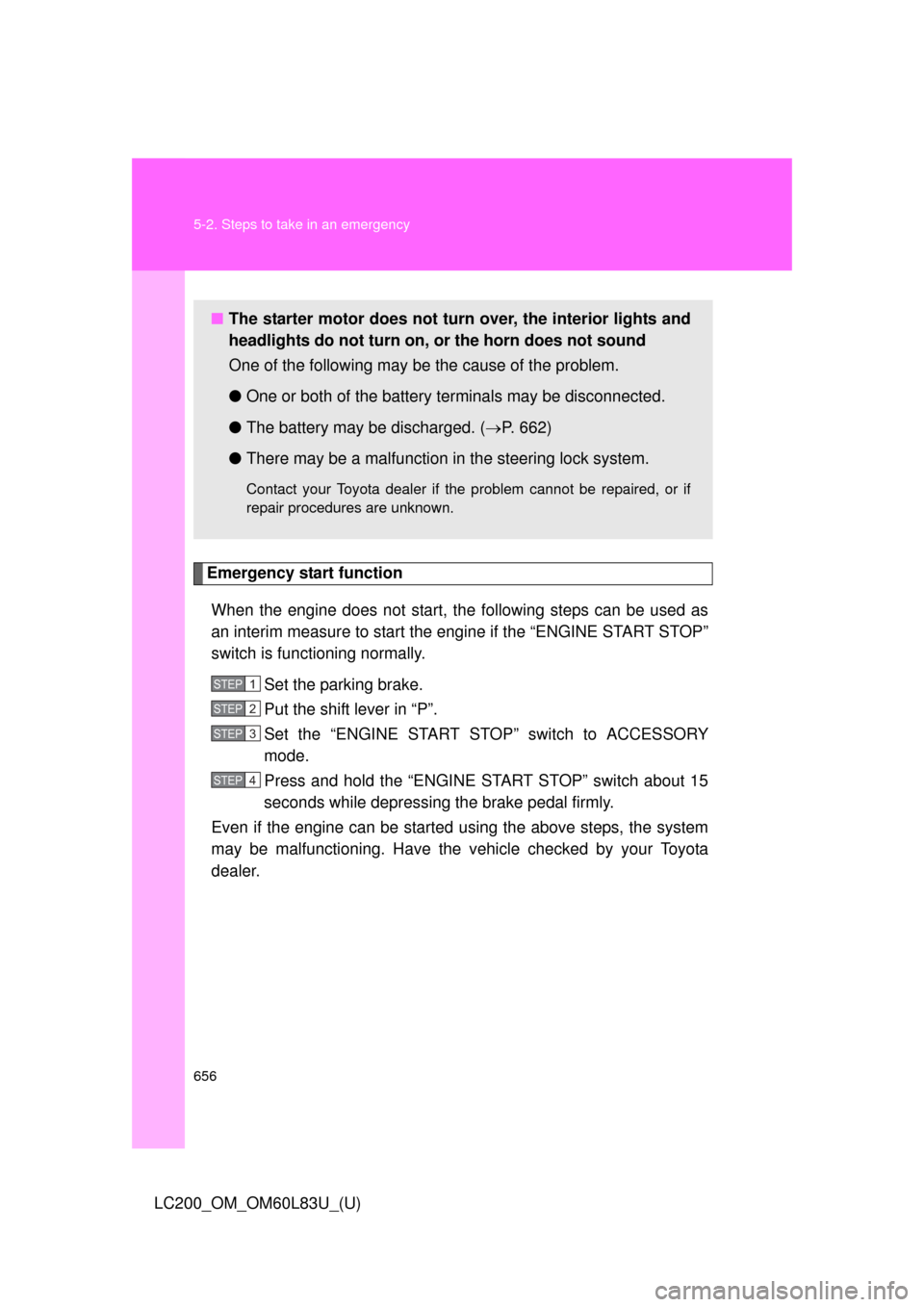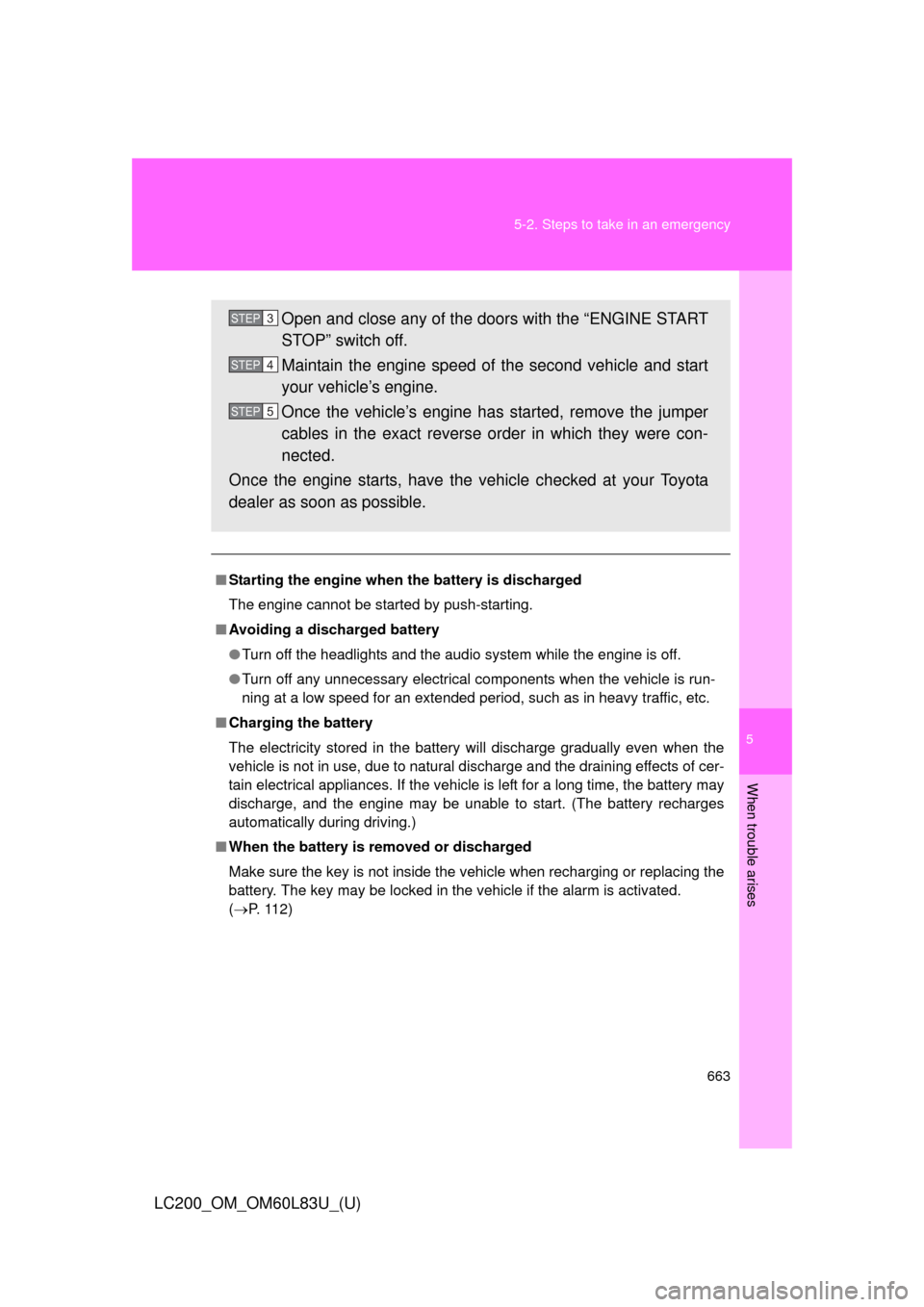Page 614 of 728

614
LC200_OM_OM60L83U_(U)
5-2. Steps to take in an emergency
If a war ning light tur ns on or a war ning buzzer sounds...
Stop the vehicle immediately. Continuing to drive the vehicle
may be dangerous.The following warning indicates a possible problem in the brake sys-
tem. Immediately stop the vehicle in a safe place and contact your
Toyota dealer.
*: Parking brake engaged warning buzzer:
A buzzer will sound if the vehicle is driven at a speed of approximately 3 mph (5 km/h) or more.
Warning lightWarning light/Details
Brake system warning light (warning buzzer)
*
• Low brake fluid
• Malfunction in the brake system This light also comes on when the parking brake is not
released. If the light turns off after the parking brake is
fully released, the system is operating normally.
Calmly perform the following actions if any of the warning lights turn
on or flash. If a light turns on or flashes, but then turns off, this does
not necessarily indicate a malfunction in the system.
However, if this continues to o ccur, have the vehicle inspected by
your Toyota dealer.
Page 620 of 728

620 5-2. Steps to take in an emergency
LC200_OM_OM60L83U_(U)
■SRS warning light
This warning light system monitors the following:
●The airbag sensor assembly
● Front impact sensors
● Side impact sensors (rear)
● Side impact sensors (front door)
● Safing sensor (rear)
● The driver’s seat belt buckle switch
● The driver’s seat position sensor
● Front passenger’s seat belt buckle switch
● The airbags
● The interconnecting wiring and power sources
● The front passenger occupant classification system
● “AIR BAG ON” and “AIR BA G OFF” indicator lights
● The seat belt pretensioners
● The “RSCA OFF” indicator light
■ Changing the engine oil
Make sure to reset oil change system
■
When the tire pressure warning light comes on
Check the tire inflation pressure and adjust to the appropriate level.
Pushing the tire pressure warning reset switch does not turn off the tire
pressure warning light.
■The tire pressure warning light ma y turn on due to natural causes
The tire pressure warning light may turn on due to natural causes such
as natural air leaks or tire inflation pressure changes caused by temper-
ature. In this case, adjusting the ti re inflation pressure will turn off the
warning light (after a few minutes).
Page 655 of 728

5
When trouble arises
655
5-2. Steps to take in an emergency
LC200_OM_OM60L83U_(U)
If the engine will not star t
If the engine still does not start after following the correct starting
procedure ( P. 170) or releasing the steering lock (P. 172), confirm
the following points.
■ The engine will not start when the starter motor operates
normally
One of the following may be the cause of the problem.
●There may not be sufficient fuel in the vehicle’s tank.
Refuel the vehicle.
● The engine may be flooded.
Try to restart the engine once more following correct starting
procedures. ( P. 170)
● There may be a malfunction in the engine immobilizer system.
( P. 108)
■ The starter motor turn over slowly, the interior lights and
headlights are dim, or the horn does not sound or sounds at
a low volume
One of the following may be the cause of the problem.
●The battery may be discharged. ( P. 662)
● The battery terminal connec tions may be loose or corroded.
■ The starter motor does not turn over
The engine starting system may be malfunctioning due to an
electrical problem such as an open circuit or a blown fuse. How-
ever, an interim measure is available to start the engine.
(
P. 656)
Page 656 of 728

656 5-2. Steps to take in an emergency
LC200_OM_OM60L83U_(U)
Emergency start functionWhen the engine does not start, the following steps can be used as
an interim measure to start the engine if the “ENGINE START STOP”
switch is functioning normally. Set the parking brake.
Put the shift lever in “P”.
Set the “ENGINE START ST OP” switch to ACCESSORY
mode.
Press and hold the “ENGINE START STOP” switch about 15
seconds while depressing the brake pedal firmly.
Even if the engine can be start ed using the above steps, the system
may be malfunctioning. Have the vehicle checked by your Toyota
dealer.
■ The starter motor does not turn over, the interior lights and
headlights do not turn on, or the horn does not sound
One of the following may be the cause of the problem.
● One or both of the battery terminals may be disconnected.
● The battery may be discharged. ( P. 662)
● There may be a malfunction in the steering lock system.
Contact your Toyota dealer if the problem cannot be repaired, or if
repair procedures are unknown.
STEP1
STEP2
STEP3
STEP4
Page 663 of 728

5
When trouble arises
663
5-2. Steps to take in an emergency
LC200_OM_OM60L83U_(U)
■
Starting the engine when the battery is discharged
The engine cannot be started by push-starting.
■ Avoiding a discharged battery
●Turn off the headlights and the audio system while the engine is off.
● Turn off any unnecessary electrical components when the vehicle is run-
ning at a low speed for an extended period, such as in heavy traffic, etc.
■ Charging the battery
The electricity stored in the battery will discharge gradually even when the
vehicle is not in use, due to natural discharge and the draining effects of cer-
tain electrical appliances. If the vehicle is left for a long time, the battery may
discharge, and the engine may be unable to start. (The battery recharges
automatically during driving.)
■ When the battery is removed or discharged
Make sure the key is not inside the vehicle when recharging or replacing the
battery. The key may be locked in the vehicle if the alarm is activated.
(P. 112)
Open and close any of the doors with the “ENGINE START
STOP” switch off.
Maintain the engine speed of the second vehicle and start
your vehicle’s engine.
Once the vehicle’s engine has started, remove the jumper
cables in the exact reverse order in which they were con-
nected.
Once the engine starts, have the vehicle checked at your Toyota
dealer as soon as possible.STEP3
STEP4
STEP5
Page 679 of 728
679
6-1. Specifications
6
Vehicle specifications
LC200_OM_OM60L83U_(U)
Cooling system
Ignition system
Electrical system
Capacity17.6 qt. (16.7 L, 14.7 Imp.qt.)
Coolant type
Use either of the following:
• “Toyota Super Long Life Coolant”
• Similar high-quality ethylene glycol- based non-silicate, non-amine, non-
nitrite, and non-borate coolant with
long-life hybrid organic acid technol-
ogy
Do not use plain water alone.
Spark plug
Make
GapDENSO SK20HR11
0.043 in. (1.1 mm)
NOTICE
■ Iridium-tipped spark plugs
Use only iridium-tipped spark plugs. Do not adjust gap when tuning engine.
Battery
Open voltage at 68 F (20 C):12.6 12.8 V Fully charged
12.2 12.4 V Half charged
11 . 8 12.0 V Discharged
(Voltage is checked 20 minutes after
the engine and all lights turned off.)
Charging rates5 A max.
Page 683 of 728
683
6-1. Specifications
6
Vehicle specifications
LC200_OM_OM60L83U_(U)
Light bulbs
A: D4S high-intensity discharge
B: HB3 halogen bulbs
C: Wedge base bulbs
D: Double end bulbs
E: Single end bulbs
F: H16 halogen bulbs
Light bulbsBulb No.WTy p e
Exterior
Headlights
Low beam
High beam
900535
60A
B
Front turn signal lights7444NA28C
Front side marker lights5C
Fog lights19F
Rear turn signal lights16C
Back-up lights92116C
License plate lights5C
Interior
Front interior light8C
Rear interior lights With rear personal lights
Without rear personal lights
8
8C
D
Front personal lights8C
Rear personal lights8C
Vanity lights2E
Door courtesy lights5C
Glove box light1.2C
Page 705 of 728
705
6-2. Customization
6
Vehicle specifications
LC200_OM_OM60L83U_(U)
ItemFunctionDefault
settingCustomized setting
Illumination
(P. 466) Time period
before the interior
lights turn off
15 secondsOff
O—O
7.5 seconds
30 seconds
Operation after
the “ENGINE
START STOP”
switch is turned
off On
Off — — O
Operation when
the doors are
unlocked On
Off — — O
Operation when
you approach the
vehicle with the
electronic key on
your person
(When the inte-
rior light switch is
door position) On
Off — — O
Sensitivity of the
ambient light sen-
sor used for dim-
ming the meter
lights etc. Standard -2 to 2 — — O
Sensitivity of the
ambient light sen-
sor used for
brightening the
meter lights etc. Standard -2 to 2 — — O